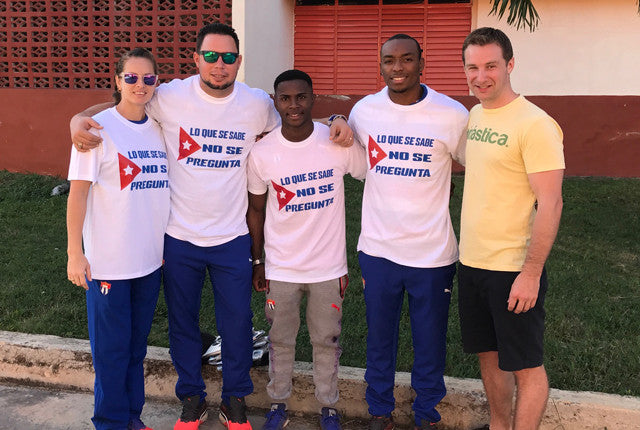The Cuban Mystique
Posted: Jul 31 2017

Hailing from a small nation myself (Wales; population 3 million), I was intrigued growing up by how other smaller nations seemed to quite frequently beat the odds and successfully compete against, sometimes even beating, the world’s powerhouses such as Japan, China, and USSR/Russia. As for Wales, well unfortunately, we were quite far from doing that ourselves!
 One of my first memories of this came as a bright-eyed 13-year-old getting to experience my first live World Championships, which conveniently for me, were being held only 30 minutes away in the industrial city of Birmingham, England. Not many gymnasts had facial hair, but one gymnast stood out to me more than any other; not for his fantastic moustache, nor for being what for me felt like a million miles away, but for being the first gymnast to compete a triple twisting vault in competition. Wow! I was still learning to straighten out my piked Tsukahara at the time and here’s a guy competing one whole twist more than any other competitor. Eric Lopez, who followed a string of famous Cuban vaulters, most notably Felix Roche (handspring double-front) and Jorge Cuervo (handspring half-turn to back layout), became a household name in Cuba. Between being amazed by Liukin’s triple back on floor, Pae Gil-Su’s beautiful line on pommel horse, and Scherbo’s graceful all-around performance, I remember pondering to myself how on earth does Cuba, a small Caribbean island, produce gymnasts capable of such innovation and power.
One of my first memories of this came as a bright-eyed 13-year-old getting to experience my first live World Championships, which conveniently for me, were being held only 30 minutes away in the industrial city of Birmingham, England. Not many gymnasts had facial hair, but one gymnast stood out to me more than any other; not for his fantastic moustache, nor for being what for me felt like a million miles away, but for being the first gymnast to compete a triple twisting vault in competition. Wow! I was still learning to straighten out my piked Tsukahara at the time and here’s a guy competing one whole twist more than any other competitor. Eric Lopez, who followed a string of famous Cuban vaulters, most notably Felix Roche (handspring double-front) and Jorge Cuervo (handspring half-turn to back layout), became a household name in Cuba. Between being amazed by Liukin’s triple back on floor, Pae Gil-Su’s beautiful line on pommel horse, and Scherbo’s graceful all-around performance, I remember pondering to myself how on earth does Cuba, a small Caribbean island, produce gymnasts capable of such innovation and power.
23 years on, I seek to answer that lingering question on a visit to the Nacional Escuela de Alto Rendimiento (National School of High Performance) in the suburbs of Havana, Cuba – a trip which was interrupted by the death of former leader, Fidel Castro. Answering my long-standing question comes at an interesting time for those of us who work within the United States. Perhaps it could unearth ways to better utilize the vast resources at USA Gymnastics’ disposal and improve the results of the men’s program on the international stage. I find it a useful approach to further my personal development as a coach to always be learning from others, something Japan do very well, and perhaps USA could too. Today, the Cuban legacy continues with one of the most exciting gymnasts to emerge in recent years, 2015 World AA Silver medalist, Manrique Larduet. So, I will get back on track, and dive into exploring how Cuba, a country of 11 million people (less than the population of Ohio!) continue to create such phenomenal gymnasts.
As with any focus on Cuba, it is impossible to overlook the political history that shaped the country and so this is where I start. In 1959, a guerilla army led by Fidel Castro and Ernesto “Che” Guevara overthrew the US-backed government, establishing a new communist government. Like many communist countries, sport was quickly used as a political tool with the idea that sporting successes on the international stage would be a reflection of the health of the political ideology in general. To this day, sport is amazingly listed in Cuba’s constitution four times as a basic human right for all, highlighting the importance the Cuban government gives to sport. Prior to the revolution, sport was predominantly an elite pastime for wealthy Cubans but Castro and his party quickly ripped open the doors to the island’s exclusive athletics clubs and set up new agencies to encourage mass sports participation across the country. Sport was now not only accessible, but widely encouraged. This was done for two reasons, firstly to improve the general health of the nation, and secondly, to ensure any talent was uncovered and given the chance to be developed into an international champion. These new agencies built and set up a system of local, regional, and national sports schools where sport could be practiced alongside studies and work.
To support this impressive system and investment, the Cuban sports commission took advantage of its nation’s strong ties to the Soviet Union and other communist nations who at the time dominated Olympic disciplines, including gymnastics. Cuban coaches were sent over to the USSR to study gymnastics at university and also took advantage of extended visits from Soviet coaches who brought with them the most up to date gymnastics knowledge, techniques, and methods. These tactics proved massively successful with Cuba quickly rising up the ranks within the world of gymnastics, with the pinnacle being the 1991 Pan-American Games, where Cuba swept every gold medal available in men’s gymnastics.
Casimiro Suarez, the current Assistant Coach at Ohio State University, was a key member of that 1991 team. The charismatic Suarez enjoyed all the benefits the top athletes were afforded by the Cuban government; high living standards, excellent food, access to top medical support, even offers of houses and cars for international success; life was sweet. Suarez and his team, coached by the Soviet Eugenia Belev, traveled to the Soviet Union annually, where they stayed for two months training and competing in the communist countries. “We were used as test crash dummies” jokes Suarez, referring to Soviet coaches trying out new methods and techniques before applying it to their own gymnasts.
However, the glory days came to an end with the demise of the Iron Curtain and the breakup of the Soviet Union in the late 1980’s and early 90’s. Cuba’s support system evaporated and the nation moved into what is known as the “Special Period”. With the Cuban economy in free-fall, the system that developed hugely successful coaches and athletes had its life line cut. Food shortages and economic hardship pursued as the small Caribbean nation faced increased isolation. Funding for sport dried up causing a vast diaspora of Cuban athletes and coaches to predominantly South and Central America, and the United States. After the high of 1991’s successes, Suarez left his beloved Cuba for a job coaching the junior women’s national team in Brazil, an option that would allow him better provide for his family. The wave of talent that left the island during the Special Period hugely impacted Cuba’s ability to compete on the international stage.
Having competed against the current University of Georgia Assistant Coach, Charlie Tamayo, at two World Championships, I was eager to hear about his experience. Tamayo was Cuba’s first World Championship medalist (bronze on vault, 2001) and grew up during this climate of struggle in the 90’s when sport was still viewed as a way out of poverty. At the ripe old age of nine, Tamayo was selected by national team coaches from his small regional school to move to the national school of gymnastics. A huge achievement that made family and friends extremely proud. Not only would Tamayo enjoy high living standards and access to the best facilities in the country, academically he would also be better off. However, with the majority of Cubans facing real hardship, Tamayo battled with the mental juxtaposition of enjoying the benefits of life at the national center while his family were struggling. “I used to smuggle out steaks” Tamayo says, reminiscing about his attempts to help his family who with the general population were dealing with a limited supply of food. It was a tough period for Tamayo, but he believed if he worked hard and gained international success for his country he would be rewarded. Upon returning to Cuba after the World Championships in 2001, Tamayo’s success did not translate into any material benefits, and despite promises of the contrary, he was no better off. The funding for sport that was enjoyed by previous generations was just not there anymore and frustrations grew amongst Cuba’s top athletes.
The day after qualifying for a spot at the 2004 Olympic Games while attending the 2003 World Championships in Anaheim, CA, Tamayo defected, leaving the team hotel and not looking back. Tamayo was one of three gymnasts who defected during that trip, something that has plagued Cuban national teams in all sports, and in gymnastics as recently as the 2015 Pan-Am Games in Toronto. The dire situation and high number of defectors saw Cuban success dry up. The fall from grace was most visible tracking Pan-Am Games success, where from the high of 1991, Cuba failed as a nation, in all sports, to win even one bronze at the 2007 edition!
With a thawing of restrictions under the Obama administration over the last several years, the Cuban economy has shown signs of recovering. Houses and streets may still be in disrepair in certain areas, but Old Town Havana is starting to be regenerated to better accommodate the growing tourist industry. I left the city center and traveled out to the suburbs in a beautiful old blue ’59 Chevy to the national school of gymnastics where I met with current head coach Carlos Gil and his current star gymnasts; Manrique Larduet and Randy Leru. Fully outfitted head-to-toe in European sports brands and carrying cell phones, it is obvious money had returned.
Gil soon painted a different picture however, complaining that they no longer had the impressive pool of coaches and athletes, the resources, nor he depth of knowledge they once had, unable to even field a team at the 2015 World Championships. Gil complained that they are still training on the apparatus that was donated by the FIG in 2001, but they make do. Despite officially being a communist state still, Cuba, under current leader Raul Castro, has slightly relaxed some aspects of communism. Nationalist propaganda billboards may still be found on every main street and the national news is still largely under government restrictions, but gymnasts once again enjoy a living stipend and now get to keep international prize monies. Larduet and Leru can often been seen enjoying posting to social media on the still hard to obtain wifi, keeping teen angst at bay! Gil is positive for the future though, as a young talented team starts to emerge and the lure of wanting to leave for greener pastures wanes. Team Cuba will be back stronger than the last decade, but whether they will be able to surpass or even match the successes of the 70’s, 80’s, and 90’s, we’ll have to wait and see!
The ups-and-downs of the Cuban economy had massive impacts on the level of sporting achievements over the decades, but what did not change was the importance the government gave to sport in its society, after all, it was in the constitution as a human right. This commitment was the driving factor behind Cuba’s ability to compete on the global stage. Money can be easily misspent and often does by many Federations, but in Cuba’s case, it allowed the Federación Cubana de Gimnasia to create a system of coaching education, talent identification, talent nurturing, and supported at its peak, the lives of its athletes in and out of the gymnasium.
When I wrote about the rise of gymnastics in Great Britain two years ago, it was a similar story; government support or the injection of capital, combined with an effective system of elite coaching education and support of their athletes, translated to success. Most nations would be envious of the financial wealth and number of talented coaches and athletes the USA enjoys, but on the international stage, Team USA has arguably plateaued. Both Cuba and Britain rose to prominence due to an investment in educating its coaches, that ensures even a limited pool of talent is maximized. USA Gymnastics’ new High-Performance Director, Brett McClure, has quite the job, but I am personally excited about his injection of youthful energy and new ideas into the program. We just hope he will be given the support and resources needed to make the necessary changes. In the meantime, looking ahead to this year’s World Championships and comparing Cuba’s top gymnast, Manrique Larduet against USA’s greatest, my money is on Larduet!
Written by TURN Managing Director and Founder, David Eaton
References:
Pettavino Paula J & Geralyn Pye. 1994. "Sport In Cuba, The Diamond In The Rough." University of Pittsburg Press
Pineda, Reinaldo Cedeño. 2008. "La Gimnasia Cubana... En Un Agujero Negro?" Trans. "Cuban Gymnastics... In A Black Hole?" laespinadelolimpo.blogspot.com/2008/01/la-gimnasia-cubana-en-un-hueco-negro-i.html?m=1



Comments
“Both Cuba and Britain rose to prominence due to an investment in educating its coaches”…so did the US women. Their story shares some elements with that of the British men. It’s not often talked about, but a good description can be found in Dvora Myers’ book “The End of the Perfect 10”. Government support such as that seen in Japan or GBR will not be forthcoming in the USA, but the US women certainly did fine without it.
Excellent review of what Cuban gymnastics was in its golden age, and what we can wait in this new cycle with Larduet and Leru.